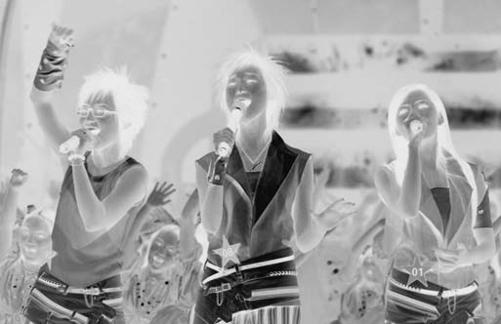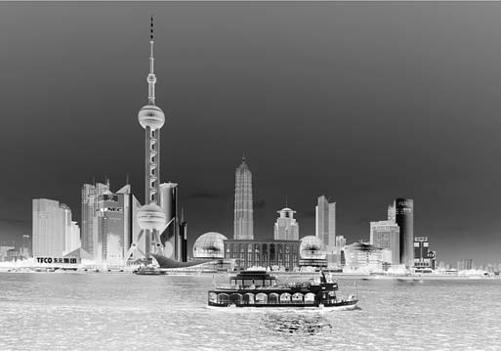Modern China. A Very Short Introduction (20 page)
Read Modern China. A Very Short Introduction Online
Authors: Rana Mitter

The programme strongly endorsed the reform programme
of CCP General Secretary Zhao Ziyang. Yet it was not merely
the expression of one set of views within the leadership.
Instead, it had a powerful political agenda of its own,
expressed in the line ‘Many things in China, it seems,
should return to May Fourth’. The May Fourth Movement
of 1919, with its catchphrase that China needed ‘science and
democracy’, was at the centre of the fi lm-makers’ agenda.
However, to say that the promise of May Fourth had not
been fulfi lled was dangerous indeed. For the CCP itself drew
its legitimacy from the fact that it had risen up during the
May Fourth era, and that Mao himself had taken part in the
Is C
hinese c
intellectual ferment of the time. The makers of
Heshang
made their agenda explicit at the very end of episode six:
ulture modern?
they declared that a dictatorial government was marked
by ‘secrecy, rule by an individual, and the fi ckleness of his
temperament’, whereas democracy was about ‘transparency,
responsive to popular will, and a scientifi c approach’. The
reference to conservative elements in the CCP, and Mao’s
legacy, was clear.
The programme created a craze: discussions of it turned up
in the newspapers, and letters were sent in their thousands
to the television station. Even the bastions of Party orthodoxy
such as the
People’s Daily
newspaper reprinted parts of the
script and printed discussions relating to the series’ message.
The events of 3–4 June 1989 ended the thaw in public
discussion of which
Heshang
had been one of the most
important parts. In autumn 1989, a roundtable of major
historians was put together to condemn
Heshang
as
reactionary, full of historical errors, and unnecessarily
abusive of the Chinese people. In retrospect, the programme
131
does seem to be a historical piece in its almost naïve
enthusiasm about the power of Western thought to transform
China. Yet the programme was an immensely daring
attempt to take on old orthodoxies, but also to use China’s
past (the May Fourth Movement) to advocate an alternative
path. Occasionally, television programmes have shaken an
entire society. In the US,
Roots
(1977) forced the country to
reconsider its legacy of slavery. In the UK,
Cathy Come Home
(1966) revealed that the lives of Britain’s poor could be torn
apart by homelessness. For China, there has never been, and
may never be again, a television programme as serious, as
compelling, as important as
Heshang
.
River Elegy
’s condemnation of what it regarded as the outdated, inward-looking Chinese civilization daringly included Mao, the
hina
‘false peasant emperor’, in the list of factors that had held China back. Hundreds of millions of Chinese may well have watched at
Modern C
least some of
River Elegy
’s six episodes before it was banned in the aftermath of Tian’anmen Square in 1989.
River Elegy
marked the last gasp for the ‘new May Fourth movement’ of the 1980s, a joyous, in some ways naïve enthusiasm for Western culture as a mechanism to ‘save China’. The more nationalistic, post-Cold War politics of the 1990s was similarly refl ected in the television of the era. A particularly notable series was the 1993 comedy-drama
A Beijing Man in New York
. The series’ protagonist was a businessman who had moved to the US, and found himself at the same time resentful of patronizing American attitudes towards the Chinese, and also taking an enjoyable revenge by outdoing them in business.
River Elegy
, just fi ve years before, had envisioned America in terms of the ‘blue ocean’ that would regenerate the ‘yellow earth’ of China’s dried-out civilization.
Beijing Man
was a more ambivalent statement of Sino-American friendship, to say the least.
132

Chinese television became more professional and more diverse in the 1990s and early 2000s, although it still remained strongly under the control of the state. It also became more internationalized. One notable example was China’s contribution to the global craze for amateur singing competitions (shows such as
Pop Idol
in the UK, and
American Idol
in the US). A television station based in Hunan province launched its own version in 2005, the full title being ‘Mongolian Cow Sour Yogurt
SuperGirl
Contest’: 120,000 women took part, and the fi nal was viewed by 400 million people, who eventually phoned in to support the 21-year-old Li Yuchun from Sichuan as the winner with 3.5 million votes.
The programme was notable for many reasons.
SuperGirl
is probably the closest thing that China has had to a free nationwide
Is C
election since 1912. Certainly it was not well received by the
hinese c
offi cial national broadcaster, China Central Television (CCTV),
ulture modern?
19. In the centre, Li Yuchun, who won the
SuperGirl
singing contest
shown on Chinese television in 2005. Over 400 million people
watched, and 8 million sent text messages ‘in support’ of singers (the
word ‘vote’ was avoided because of its political implications)
133
which declared the programme ‘vulgar and manipulative’. The programme was not re-run in its original form the following year, although CCTV’s lack of enthusiasm for it may have been fuelled as much by fear for their advertising revenues being sucked away by the regional competitor station as by political worries.
SuperGirl
was also notable for how similar it was to other such contests around the world. In the post-Cold War era, the idea was often heard that politics had become almost irrelevant in the Western democracies, as there was little difference between right and left, and citizens had turned instead to materialist consumption and individual gratifi cation.
SuperGirl
suggested that this fear did not just exist in democracies: the idea of individual celebrity as a life goal was as far from the Maoist conception of the good life as could be imagined, and if it distracted young people from political dissent, so much the better, as far as the reform-era state was concerned. Television
hina
advertising of the time drove the message home. In the same year that
SuperGirl
aired, a television commercial showed a girl
Modern C
dismissing an unpleasant boyfriend, and instead drinking a soft drink, concluding with the voiceover: ‘Love yourself more’. In a print advertisement, meanwhile, a line of popular clothing was advertised with the blatantly anti-Maoist slogan ‘different from the masses’. The culture of mass-produced individuality was in China to stay.
Architecture and the modern city
Cultural forms changed around the Chinese over the 20th century, and one of the most visible of those changes, indicating the change from premodern to modern, was the way in which city planning changed forever. For centuries, Chinese cities were arranged on a predictable pattern. Travellers approaching a city would fi rst see from miles away the huge, grey-brick walls that surrounded any settlement of size. Within the city walls, the magistrate’s yamen 134
and bureaucratic offi ces would be at the centre, and commercial and residential areas would radiate out from that point.
One of the fi rst cities to violate this rule was Shanghai. Expanded as a treaty port whose primary purpose was commerce, not government, the foreign-controlled International Settlement area had a long shopping street, Nanking Road, at its centre, leading not to a government building but to the racecourse.
Although the imperialist presence was the source of great anger in China, it was also the example of modernity that was most obviously before people’s eyes, and Chinese reformers signalled their own adherence to the norms of the modern city by reproducing them.
So Canton’s great walls were destroyed by the Chinese local
Is C
administration in the 1920s, which was allied to the Nationalist
hinese c
Party (then still a regional rather than national power). In their
ulture modern?
place came commercial boulevards and highways. The Nationalist government that took power under Chiang Kaishek in 1928 had grand plans for their new capital at Nanjing: it would have arterial roads, tree-lined avenues, electric streetlights, and a palatial new party headquarters that combined features of the Temple of Heaven in Beijing and the US Capitol in Washington. Less than ten years later, the Nationalists had to withdraw from the capital, leaving most of this planning in the realms of the imagination.
The war with Japan stopped most of the great building plans, and many cities were heavily bombed, destroying many old buildings and walls.
But the single greatest period of change in China’s cityscapes has been the era since 1949. The Nationalists dreamed of using architecture as power: the Communists achieved it. Very few of China’s major cities today refl ect the topography that the residents of a hundred years ago would have known. All around China, from the 1950s, traditional city walls were knocked down; the winding 135
alleyways of the inner cities were destroyed to make way for high-rise buildings, and old temples and government offi ces were bulldozed to make way for buildings, some in the Soviet ‘gothic wedding-cake’ style, but more often in the bland language of the international modern.
Much of the rejection of China’s past that marked the Cultural Revolution – literature, philosophy, art – has been reversed since the 1980s, as the Party and the people alike seek to rediscover their own heritage. This reversal has been far less evident in city planning and architecture. To this day, large sections of China’s major cities resound with the noise of the wrecking ball and the jackhammer. A signifi cant, if partial, exception is Shanghai. A good proportion of its old colonial architecture, particularly the parts in the city centre, have been carefully preserved, and even sport heritage plaques giving details of their history. Ironically, the indigenous architecture of other cities is under greater threat. The
hina
decision to award the 2008 Olympics to the city was a great spur to building in Beijing. Yet the frenzy of building work has almost
Modern C
all been at the expense of the older buildings of the city: the old alleyways (
hutong
), with their low-rise, courtyard-style living, have been daubed all over the city with the character
chai
, meaning
‘for demolition’. The city has replaced them with tower blocks in the suburbs, and sophisticated new buildings in the centre by international architects such as Rem Koolhaas and I. M. Pei. The authorities have given many reasons for the wholesale elimination of so much of old Beijing, citing in particular the unhygienic and impractical nature of the
hutongs
for contemporary living.
Many such alleys had no running water in the houses, and the communal toilets were freezing in winter and unbearably close in summer. The old alleys of cities such as Chengdu and Kunming, charming if impractical for motor vehicles and modern plumbing, have also been razed in favour of skyscrapers and tower blocks.
But the replacements often show little evidence of a Chinese fl avour. In the early 20th century the Nationalists in Canton 136

Is C
20. In 1990, the east bank of the Huangpu River in Shanghai was
hinese c
muddy fl ats and warehouses. Now it is a metropolis of skyscrapers, a
sign of Shanghai’s return to its former signifi cance as a global centre of
ulture modern?
commerce and fi nance